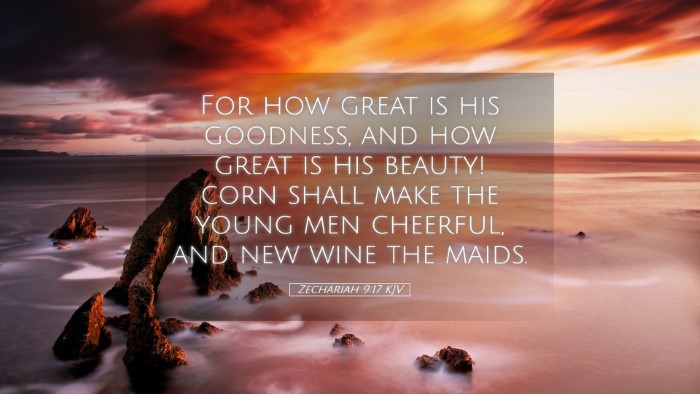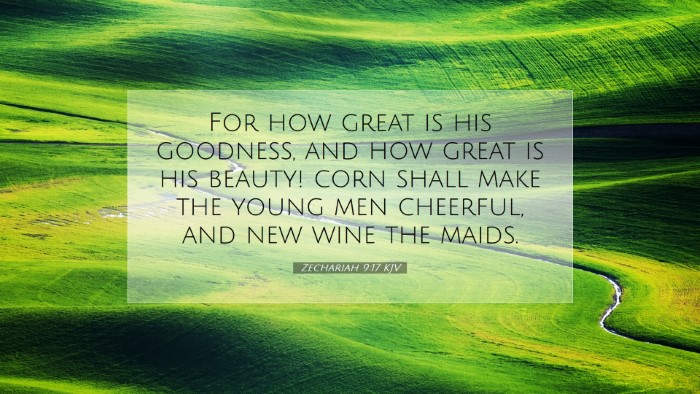Old Testament
Genesis Exodus Leviticus Numbers Deuteronomy Joshua Judges Ruth 1 Samuel 2 Samuel 1 Kings 2 Kings 1 Chronicles 2 Chronicles Ezra Nehemiah Esther Job Psalms Proverbs Ecclesiastes Song of Solomon Isaiah Jeremiah Lamentations Ezekiel Daniel Hosea Joel Amos Obadiah Jonah Micah Nahum Habakkuk Zephaniah Haggai Zechariah MalachiZechariah 9:17
Zechariah 9:17 KJV
For how great is his goodness, and how great is his beauty! corn shall make the young men cheerful, and new wine the maids.
Zechariah 9:17 Bible Commentary
Commentary on Zechariah 9:17
Text of Zechariah 9:17 (KJV): "For how great is his goodness, and how great is his beauty! corn shall make the young men cheerful, and new wine the maids."
Introduction
The Book of Zechariah is a profound text that combines prophecy, exhortation, and a vision of hope for God's people. In Zechariah 9:17, the prophet emphasizes the dual aspects of God's goodness and beauty, particularly in the context of blessing and abundance. This commentary will draw upon the insights of Matthew Henry, Albert Barnes, and Adam Clarke, weaving together their thoughts into a coherent analysis for pastors, students, and scholars.
Exegesis of the Verse
Zechariah 9:17 highlights the character of God and the blessings He is prepared to bestow upon His people. Let us break down the key elements of this verse:
- God's Goodness: The term 'goodness' reflects God's benevolence and the unfathomable mercy that He extends to His people.
- God's Beauty: The beauty of God is interpreted both in His glorious nature and the splendor of His works in creation and redemption.
- Symbolism of Corn and New Wine: Corn represents sustenance and life, whilst new wine signifies joy and celebration, thus portraying a time of plenty for both young men and maidens.
Insights from Matthew Henry
Matthew Henry's commentary emphasizes the assurance that the goodness of God brings joy and gladness. He points out that the "goodness" and "beauty" here allude to both material and spiritual blessings, which lead to communal joy among God's people. Henry notes that during the return from exile, the people would experience not only physical sustenance but also spiritual revival, as they reflect on the grace of their God.
Further, Henry interprets the text as an encouragement to the faithful, underscoring that such joy and beauty stem from a profound relationship with God, becoming evident in their lives and expressions of worship.
Insights from Albert Barnes
Albert Barnes focuses on the nature of God's blessings as described in this verse. He contextualizes the agricultural references to corn and wine, illustrating how these elements are crucial in the agricultural society of Israel. Barnes elaborates that the verse foreshadows both physical and spiritual transformation, linking the abundance of the land with the satisfaction and delight of the people.
He also relates this text to the messianic hope, indicating that such blessings are ultimately fulfilled in Christ. The joy that comes from God is apparent when one is in alignment with His purposes, and the communal experience of happiness is an acknowledgment of God's gracious provision.
Insights from Adam Clarke
In his commentary, Adam Clarke reflects on the themes of joy and abundance, highlighting that the terms "goodness" and "beauty" embody the idea of spiritual enrichment. Clarke emphasizes that the 'young men' and 'maids' represent the entirety of society, indicating collective joy in response to God's provision.
Clarke adds a critical understanding of the Hebrew language used in this verse, suggesting that the beauty of God manifests not only in His creation but also in His dealings with humanity. He articulates a vision where the future worship and life of God's people reflect the splendor of their God, as they participate actively in the life He intends for them.
Theological Themes
This verse encapsulates several theological themes that are vital for spiritual leaders and scholars alike:
- The Nature of God: An exploration into God's nature as good and beautiful invites believers to rest in His character, shaping their understanding of His interactions with humanity.
- The Role of Abundance: The imagery of corn and wine speaks to the biblical theme of provision, whereby God meets the needs of His people abundantly, symbolizing both physical and spiritual nourishment.
- Restoration and Renewal: The passage suggests a promise of restoration, where joy signifies a return to a right relationship with God after a period of suffering and dislocation.
Practical Applications for Today
For pastors, students, and theologians, the insights derived from Zechariah 9:17 can be translated into practical guidance:
- Celebrating God's Goodness: Regularly leading congregations in worship that acknowledges God's goodness fosters a culture of gratitude and joy.
- Encouraging Community Joy: Creatively engaging with the community to celebrate various blessings can reflect the joy God offers, helping to build a closer-knit church community.
- Emphasizing Spiritual Nourishment: Teaching on spiritual abundance and fulfillment derived from a relationship with God can help believers to navigate struggles with hope and joy.
Conclusion
Zechariah 9:17 invites us into a deeper understanding of God's character as it relates to goodness and beauty. The reflections from Matthew Henry, Albert Barnes, and Adam Clarke enrich our comprehension of the text, showcasing how divine blessings operate within the lives of believers. In a world often marked by scarcity and despair, this verse serves as a potent reminder of the richness available in a relationship with God, encouraging believers to rejoice in His abundant provision.


